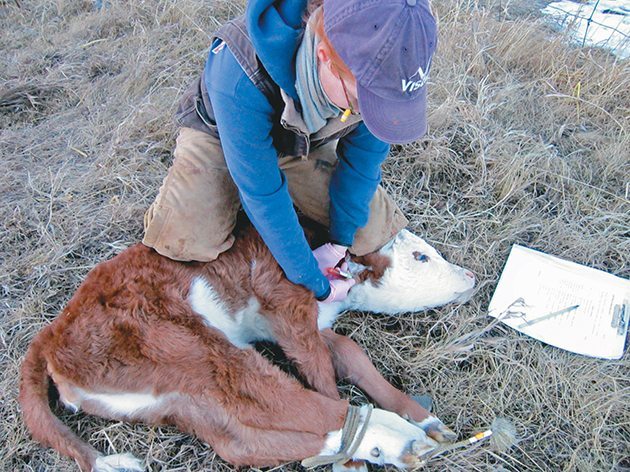Trials look at factors affecting a calf’s suckle reflex and its ability to consume colostrum immediately after birth
A University of Calgary professor is working to develop a scoring system that can predict a calf’s ability to consume colostrum on its own.
Adequate immunity acquired through colostrum is the most im-portant factor affecting pre-weaning health of beef calves, said Elizabeth Homerosky, a veterinarian and Simpson Ranch Fellow at the U of C.

One-third of beef calves in Alberta and Saskatchewan have less than optimal immunity and are predisposed to pre-weaning health issues and mortality, according to a study from 2009.
This makes good newborn vigour a vital survival trait.
“While various newborn calf scoring systems, modelled after the original APGAR system in infants, have been used over the last few decades as a means to classify vigour status, none are predictive of a calf’s ability to consume colostrum in a timely manner,” Homerosky said.
She wanted to create a quick and accurate tool that producers could use shortly after a calf is born to predict one of the most critical activities in a newborn calf’s life.
Read Also

No special crop fireworks expected
farmers should not expect fireworks in the special crops market due to ample supplies.
Her trial was conducted in March 2014 on an 800-head commercial ranch in southern Alberta comprising purebred Hereford and Hereford-Red Angus crossbred cattle.
Homerosky is working under the assumption that calves born unassisted are considered to be low risk for failed transfer of passive immunity, while calves with assisted births are considered high risk.
The final data analysis is expected to be completed this fall.
She noticed during the trial that it is common for producers to automatically bottle or tube feed calves from hard pulls. In her study, 85 percent of unassisted calves sucked on their own before the four-hour mark compared to 60 percent of easy pulls and 35 percent of hard pulls.
“Although the impacts are generally worse for calves failing to consume colostrum in a timely manner, un-necessary bottle or tube-feeding may also have consequences,” said Homerosky.
“Negative effects include disrupting the maternal bond, interfering with the calf’s natural desire to suck or even causing aspiration pneumonia and possibly death.”

She said preliminary results suggest suckle reflex is a promising predictor of a calf’s ability to consume colostrum.
“This is a subjective assessment performed by placing two fingers lengthwise in the calf’s mouth and categorizing the strength of the calf’s attempt to suck as weak, moderate, or strong.”
Regardless of calving ease, 85 percent of calves with strong suckle reflex sucked on their own before the four-hour mark, while 60 percent of calves with a moderate suckle reflex sucked on their own. In contrast, only seven percent of calves with a weak suckle reflex sucked on their own.
Based on blood work, Homerosky also found that the suckle reflex may be affected by acidosis because calves with a weak suckle reflex had lower blood pH and higher lactate levels, which could indicate prolonged oxygen deprivation at birth.
“By combining suckle reflex with calving ease and several other physical exam parameters in a simple statistical model, we will ideally be able to advise producers how to more accurately predict which calves will suck on their own and which calves will require help,” said Homerosky.
Other factors that appear to be promising include dam parity, the calf’s gum colour and the ability of the calf to fully retract its tongue when pinched.
“We are hoping that we can use this to accurately identify, by 10 minutes after birth, calves that will have difficulty sucking on their own,” said Homerosky.
“However, from a management standpoint, it would be a good idea to develop a protocol focusing on colostrum delivery for any calf exhibiting a weak suckle reflex shortly after birth.”
Homerosky said ranchers should also watch for signs of mismothering and ensuring the prevention of calf hypothermia. Along with calf vigour, these can also have a substantial impact on getting the calf off to the right start.















